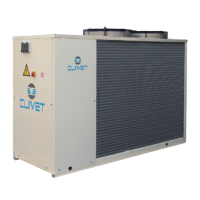9
4.1 PRELIMINARY INFORMATION
CUT-OFF VALVES
• Installed at inlet and outlet (both on the water technique
circuit as well as that of the hot domestic water) allow
maintenance operations without having to empty the
system .
THERMOMETERS AND MANOMETERS
• Installed at entry and exit of the main elements facilitate
inspection and maintenance.
AIR BLEED VALVE
• Installed in all of the highest points of the system allowing
the venting of the circuits air..
DRAINAGE TAPS
• Installed in the lowest points of the system to allow
bleeding.
EXPANSION TANK
• It keeps a correct system pressure when the water
temperature changes. It must be dimensioned as a
function of water plant volume and temperature.
WATER FILTER
• If not present on-board the machine, must be installed
immediately in the water input of the unit, in a position that
is easily accessible for cleaning.
• The filter never should be removed, this operation
invalidates the guaranty
SUPPORTS
• The hydraulic pipes weight mustn’t burden on the unit
connections ..
FLOW SWITCH
• The flow switch must be present as a component of the
system
4.3 OPERATION SEQUENCE
4.4 WATER QUALITY
The water quality is determined by the following factors, avoid
therefore:
• Inorganic salts
• pH
• Biological load (seaweeds etc)
• Suspended solids
• Dissolved oxygen
Water with inadequate characteristics can cause:
• pressure drop increase
• energy efficiency decrease
• corrosive symptom increase
If the unit or the relative water connections can be subject to
temperatures close to 0°C adopt measures for prevent risk of
freeze.
For example:
• Mix water with ethylene glycol
• Safeguard the pipes with heating cables placed under the
insulation
• Empty the system in cases of long non-use and check that:
• there are no closed taps present that could trap water
even after emptying
• there are no low points in which water can stagnate
even after emptying; carry out any blowing required .
4.5 RISK OF FREEZE
4.6 ANTI-FREEZE SOLUTION
Consider that the use of anti-freeze solution determines an
increase in a pressure drop.
Make sure that the glycol type utilized is inhibited (not
corrosive) and compatible with the hydraulic circuit
components (pump etc).
Do not use different glicol mixture (i.e. ethylene with
propylene)
Selection and installation of system components must be
carry out by installer.
Following you will find some indications to integrate with what
is provided by the local regulations in force and by the good
technical laws.
4.2 COMPONENTS
4 - WATER CONNECTIONS
4.7 WATER CONNECTIONS
• Take away the supplied connection union by acting on the
connection joint.
• Weld the union to the installation pipe.
• Perform the connection between the installation pipe and
the evaporator, using the joint.
Do not weld the system pipe with the connection joint atta-
ched.
The rubber gasket might be irreparably damaged.
1. Carefully wash the system with clean water: fill and drain
the system several times.
2. Apply additives to prevent corrosion, fouling, formation of
mud and algae.
3. Fill the plant
4. Execute leakage test.
5. Isolate the pipes to avoid heat dispersions and formation
of condensate.
6. Leave various point of service free (wells, vent-holes etc).
Neglecting the washing will lead to several filter cleaning
interventions and at worst cases can cause damages to the
exchangers and the other parts.

